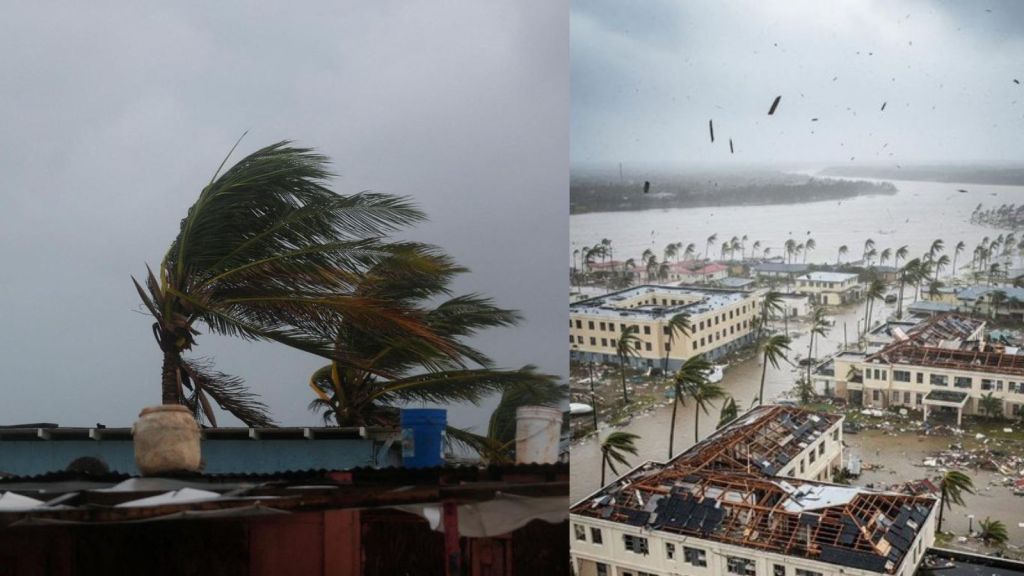Hurricane Melissa made landfall on the southern coast of eastern Cuba on Wednesday, Reuters reported. The storm has weakened to a category 3 system, the US National Hurricane Center (NHC) said in its latest advisory. Melissa was located about 60 miles (95 km) west-southwest of Guantanamo, Cuba, with winds at 120 mph (195 kph), the Miami-based forecaster said.
This comes after the hurricane made landfall in Jamaica on Tuesday as a Category 5 storm, one of the strongest hurricanes the island has faced since records began in 1851, reports CNN. The storm battered the entire region, leaving behind a trail of destruction before weakening to a Category 4 system near mountain areas.
Hurricane Melissa devastates Jamaica, heads toward Cuba
In Jamaica, Melissa made landfall near New Hope on the region’s southern coast, with winds recorded at 185 mph (298 kph), the same as the intensity of Hurricane Dorian, which devastated the Bahamas in 2019. The US National Hurricane Centre (NHC) warned that “total structural failure is likely near the path of Melissa,” especially at higher altitudes where wind speeds reached 215 mph before landfall.
Look at these devastating photos coming from all over Jamaica…..this is in St. Elizabeth 🙏🏾 and Hurricane Melissa is still destroying the island! 💔 pic.twitter.com/4KlXKUvWLf
— Lucas Sanders 💙🗳️🌊💪🌈🚺🟧 (@LucasSa56947288) October 28, 2025
The storm damaged homes, uprooted trees, and ripped roofs from buildings. Emergency officials said parts of St Elizabeth parish were completely underwater, while severe damage was also reported in Clarendon and Westmoreland.
Desmond McKenzie, deputy head of Jamaica’s Disaster Risk Management Council, said the situation in the southwest was tragic and bad. “Roofs were flying off,” he said. “We’re hoping and praying the weather eases so that rescuers can reach trapped families.”
According to the Guardian, nearly three families were trapped in their homes in the Black River area, but officials say the storm’s intensity and impact have made rescue attempts nearly impossible so far.
Prayers to Jamaica 🇯🇲 🙏🙏🙏
— Svrge 👑 (@kingsvrge_) October 28, 2025
Jamaica is being slammed by one of the strongest hurricanes in world histor. Hurricane Melissa, has hit winds of over 180 mph and gusts up to 225 mph.#Prayers #Jamaica pic.twitter.com/cfFI0D899w
Hurricane Melissa impact: Hospitals and infrastructures damaged
A hospital in St Elizabeth was badly damaged when parts of its roof collapsed. Health Minister Christopher Tufton said 75 patients had been moved to higher floors before the collapse.
Several videos shared on social media showed flooded roads, fallen trees, and flying rooftops across southern Jamaica. One clip appeared to show the Savanna La Mar hospital’s roof getting ripped off, while another showed medical staff on duty while battling storm and power outages.
By Tuesday evening, more than 15,000 Jamaicans had taken shelter in 382 emergency centres, the Guardian reported. Officials warned that entire communities may remain deprived of electricity and basic necessities, as blocked roads make access difficult.
BREAKING: Horrific flooding in Santa Cruz, Jamaica, as Historic Category 5 Hurricane Melissa made landfall.
— Brian Krassenstein (@krassenstein) October 28, 2025
I fear that the destruction from this storm will be catastrophic. pic.twitter.com/cv4mdb1pTB
Hurricane Melissa impact: Aid and rescue efforts underway
Rescue agencies are preparing for a relief effort once conditions improve. The Red Cross said around 1.5 million people could be directly affected, calling it “the largest disaster in Jamaica’s modern history.”
The Jamaican government has urged residents to save at least three days’ worth of drinking water and avoid returning to damaged homes. “It will cause catastrophic damage, life-threatening damage,” said Evan Thompson, director of Jamaica’s Meteorological Service.
Hurricane Melissa: Cuba prepares for landfall
Cuban President Miguel Díaz-Canel has warned the storm could be “one of the most severe, or possibly the strongest, hurricanes ever to hit the island.”
The NHC is expecting the storm to make its second landfall on late Tuesday or early Wednesday. The expected wind speed is currently between 140 and 145 mph, and a storm surge of up to 10 feet (3 meters). Thousands of Cubans spent Tuesday moving to shelters as the government ordered mandatory evacuations in vulnerable regions.
“Heavy rainfall, flash flooding, and landslides are expected soon,” said Jack Beven, senior hurricane specialist at the NHC. “Life-threatening storm surge and damaging winds are likely to begin later today. Seek safe shelter,” according to Bloomberg.
The US Navy also confirmed it had evacuated 900 non-essential personnel from its base at Guantanamo Bay ahead of the storm.
After crossing Cuba, Melissa will move towards the southeastern Bahamas. Even countries like Haiti and the Dominican Republic are expected to see flash floods and landslides, according to NHC experts.


